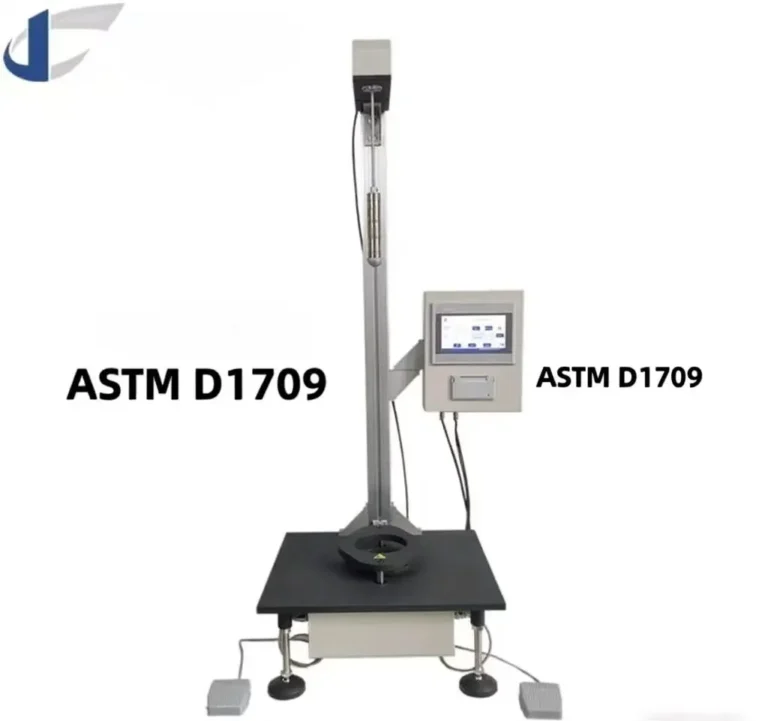Falling Dart Impact Tester: Reliable Testing for Plastic Film Durability
In flexible packaging, film toughness is essential for maintaining product integrity throughout manufacturing, distribution, and end use. The falling dart impact tester is a widely adopted solution to assess a film’s resistance to impact. It helps determine whether a film can withstand sudden external forces, such as drops or punctures, without failure.
This article explores the falling dart testing process, its significance in packaging, and its connection to ASTM D1709—the industry standard that defines the dart impact test method. We will also introduce the Cell Instruments FDT-01 Falling Dart Impact Tester for high-accuracy lab and production testing.
Dart Impact Test Method and ASTM D1709: Why They Matter
The dart impact test method, as defined by ASTM D1709, is a standardized procedure to determine the impact resistance of plastic films and sheets. This method involves dropping a hemispherical dart of specific mass from a known height onto a clamped film specimen. The result is either a pass or fail, depending on whether the sample ruptures.
There are two common testing methods:
Method A: Uses a 38 mm diameter dart and tests materials with lower impact resistance.
Method B: Uses a 50 mm diameter dart, ideal for tougher materials or multilayer films.
The ASTM D1709 standard provides a reliable benchmark for comparing materials, qualifying suppliers, and supporting quality assurance programs.
Benefits of Using a Falling Dart Impact Tester
Falling dart impact testing serves multiple purposes across industries:
Packaging validation: Ensures films used in food, pharma, or industrial applications won’t fail under load or during transport.
Material comparison: Allows R&D teams to evaluate new film formulations, coatings, or treatments.
Cost optimization: Helps balance material performance and thickness to reduce cost without compromising quality.
Compliance: Supports adherence to international testing standards like ASTM D1709.

By adopting the falling dart impact tester, packaging professionals gain traceable, consistent, and data-driven control over film performance.
How Falling Dart Impact Testing Works
The process is straightforward and highly repeatable:
Mount the Film Sample
The film (≥150 mm × 150 mm) is clamped tightly using pneumatic clamps to ensure no slack.Select Dart Method and Weight
Choose Method A or B and adjust the dart mass accordingly—between 50 g to 2000 g.Set Drop Height
Standard heights include 660 mm or 1500 mm, depending on the film and standard requirements.Release the Dart
The dart is held by an electromagnetic mechanism and released to fall under gravity.Observe Results
The system automatically records a “fail” or “non-fail”. After multiple drops, it calculates the critical weight where 50% of specimens fail.
This process simulates real-world drop scenarios to provide a quantitative measure of impact strength.
Industry Applications of Dart Impact Testing
The falling dart impact tester is essential in industries including:
Flexible packaging manufacturing
Food and beverage packaging
Medical and pharmaceutical packaging
Plastic film production
QC and third-party testing labs
Academic and material science R&D
It applies to films made from PE, PP, PET, PVC, laminated papers, metalized films, and more, with thicknesses up to 1 mm.
Recommended Equipment: Cell Instruments FDT-01 Falling Dart Impact Tester
For organizations seeking reliable, accurate, and automated dart testing, the Cell Instruments FDT-01 is an ideal choice.
Key features include:
Support for ASTM D1709
Dual-method support: Method A and B
Adjustable dart mass: 50–2000 g
Pneumatic clamps for stable sample holding
Electromagnetic dart release system
High measurement accuracy (±0.1 g)
Touchscreen operation and automated result calculation
Conclusion
Ensuring the durability of packaging films starts with the right testing method. The falling dart impact tester is a powerful tool to assess the impact resistance of flexible materials, following international standards like ASTM D1709. When combined with accurate procedures and dependable equipment, such as the FDT-01 from Cell Instruments, manufacturers and labs can guarantee quality, optimize materials, and meet global compliance needs.
